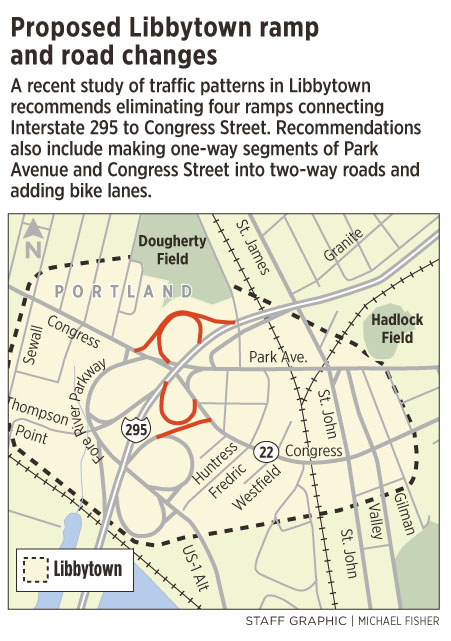PORTLAND – City officials are considering a proposal to improve the city’s Libbytown neighborhood by eliminating four interstate access ramps and converting parts of Congress Street and Park Avenue into two-way roads.
A study group looking for ways to reconnect the fragmented neighborhood will present the recommendations to the City Council’s Transportation, Sustainability and Energy Committee on Wednesday. City staffers are looking for permission to begin discussions with the Maine Department of Transportation about closing the ramps.
“I think there are some really great opportunities to remove some of the redundant ramps and open up some space for either development or open space,” said City Councilor David Marshall, who leads the transportation committee.
Libbytown is the area roughly defined by St. John Street, Union Station Plaza, Thompson’s Point and Dougherty Field. Congress Street and Park Avenue are the two major traffic corridors in the area and are considered high-crash locations by the state.
The Libbytown plan is the latest of several projects around Portland that seek to make urban streets more pedestrian- and bike-friendly, rather than just a way to move large volumes of traffic.
Other “Complete Street” projects include an effort to convert High and State streets from one-way to two-way traffic, and an effort to redesign Franklin Street.
Now, the city is anticipating a major development at nearby Thompson’s Point, a $105 million mixed-use project that is expected to draw visitors from around the region and increase traffic.
The city, along with the Portland Area Comprehensive Transportation System and a team of consultants, has been looking at ways to improve the pedestrian experience in a neighborhood that was torn apart by Interstate 295. The $100,000 study is being funded by PACTS.
The study group recommends eliminating four ramps connecting Congress Street to Interstate 295, leaving only the northbound ramp on Congress Street. If the other ramps are eliminated, traffic would have to access the interstate using ramps located on the nearby Fore River Parkway.
The city would need permission from the MDOT and the Federal Highway Administration to eliminate the ramps.
MDOT spokesman Ted Talbot said any requests to eliminate interstate ramps would be closely scrutinized.
“It’s very rare we would ever take out an on-ramp (or) off-ramp unless studies really prove to us that it’s doable for the traveler,” Talbot said.
Members of a community advisory board were largely enthusiastic about most of the proposed changes. But some expressed concern about certain elements.
Popular elements of the study include the removal of the interstate ramps, as well as the addition of bike lanes, converting Park Avenue to two-way and traffic-calming measures, such as narrowing the roadways.
“Slowing the cars down will make it a more pleasant place to walk around,” said Zachary Barowitz, a 45-year-old Huntress Street resident.
Libbytown was a quieter, more cohesive neighborhood until the early 1970s, when about 100 houses and apartment units were torn down to make way for the highway and interchange. That effectively destroyed the ethnic, working-class neighborhood.
Jaime Parker, who represents Portland Trails on the advisory board, said the recommendations would reconnect Libbytown and restore a sense of place there.
“We have a damaged urban fabric and we’re working to repair it,” Parker said. “It just doesn’t meet the need of a lot of users. People in Libbytown are pretty much stranded unless they want to get in their car.”
Other committee members, however, were concerned about converting the one-way part of Congress Street from Park Avenue to St. John Street into a two-way road.
Chaning Capuchino has lived on that stretch of Congress Street for 12 years and plans to oppose the Congress Street conversion. Capuchino said she and her neighbors fear the conversion will make traffic worse in the neighborhood.
One in-bound lane will cause traffic to back up for a longer distance whenever there is a train, Capuchino said. And the addition of an outbound lane will only increase traffic in the neighborhood, she said.
“We’re not seeing the pros outweighing the cons,” said Capuchino, a 44-year-old photographer.
The study group also recommends narrowing the Congress Street and Park Avenue intersection in front of Denny’s and adding a traffic light at that location. It also recommends redesigning the Fore River Parkway-Congress Street intersection.
The group believes that converting Park Avenue into a two-way street could be done in the near term at a relatively low cost, the study states.
Converting Congress Street into a two-way road could only be accomplished if the interstate ramps are eliminated, the study states. And streetscape improvements would likely be the final phase.
The recommendations will have to approved by the full City Council before they can be implemented.
“I’m really happy with (the recommendations),” Barowitz said. “I wish they could happen sooner.”
Randy Billings can be contacted at 791-6346 or at:
rbillings@mainetoday.com
Twitter: @randybillings
Copy the Story Link
Send questions/comments to the editors.




Success. Please wait for the page to reload. If the page does not reload within 5 seconds, please refresh the page.
Enter your email and password to access comments.
Hi, to comment on stories you must . This profile is in addition to your subscription and website login.
Already have a commenting profile? .
Invalid username/password.
Please check your email to confirm and complete your registration.
Only subscribers are eligible to post comments. Please subscribe or login first for digital access. Here’s why.
Use the form below to reset your password. When you've submitted your account email, we will send an email with a reset code.